Child Labour in Supply Chains: Analysis and Case Study Report
VerifiedAdded on 2022/12/15
|6
|1263
|255
Case Study
AI Summary
This case study examines the pervasive issue of child labour within global supply chains. The introduction defines child labour as a condition where children are compelled to work instead of attending school, often due to poverty. The main body delves into the situation where children are employed in various organizations, highlighting the impact on their education and overall well-being. It discusses the economic consequences of child labour, the existing laws and regulations aimed at protecting children, and the roles of various organizations in combating this issue. The case study references acts like the Factory Act (1833) and Mines Act (1842), and the Licensing Act 1964 as protective measures, while also exploring the causes of child labour, such as poverty and inadequate enforcement of laws. The conclusion emphasizes the need for stricter enforcement and societal efforts to eliminate child labour, ensuring children's access to education and a better future. The report underscores the detrimental effects of child labour on children's health, education, and overall development, advocating for the implementation of comprehensive strategies to eradicate this practice.
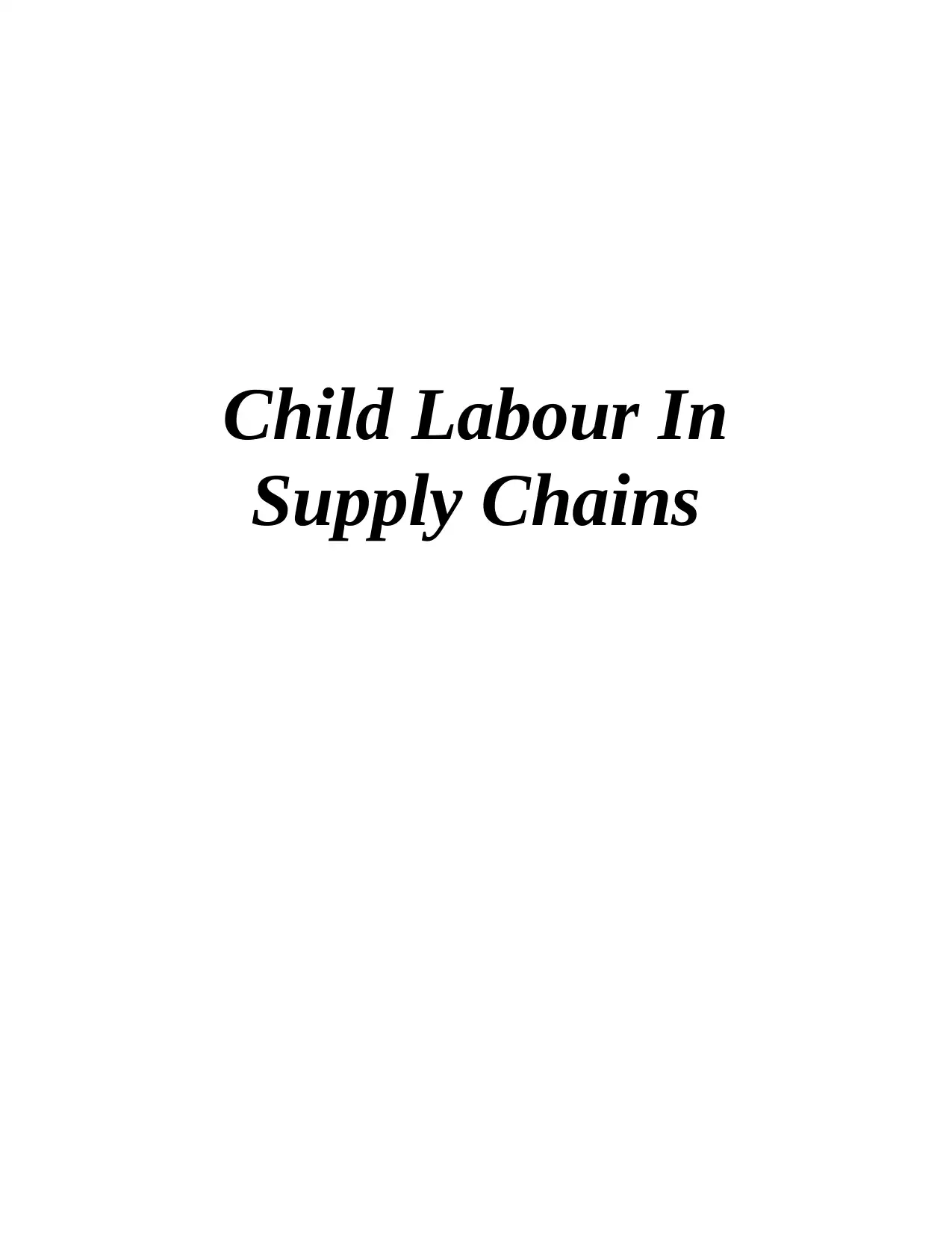
Child Labour In
Supply Chains
Supply Chains
Paraphrase This Document
Need a fresh take? Get an instant paraphrase of this document with our AI Paraphraser
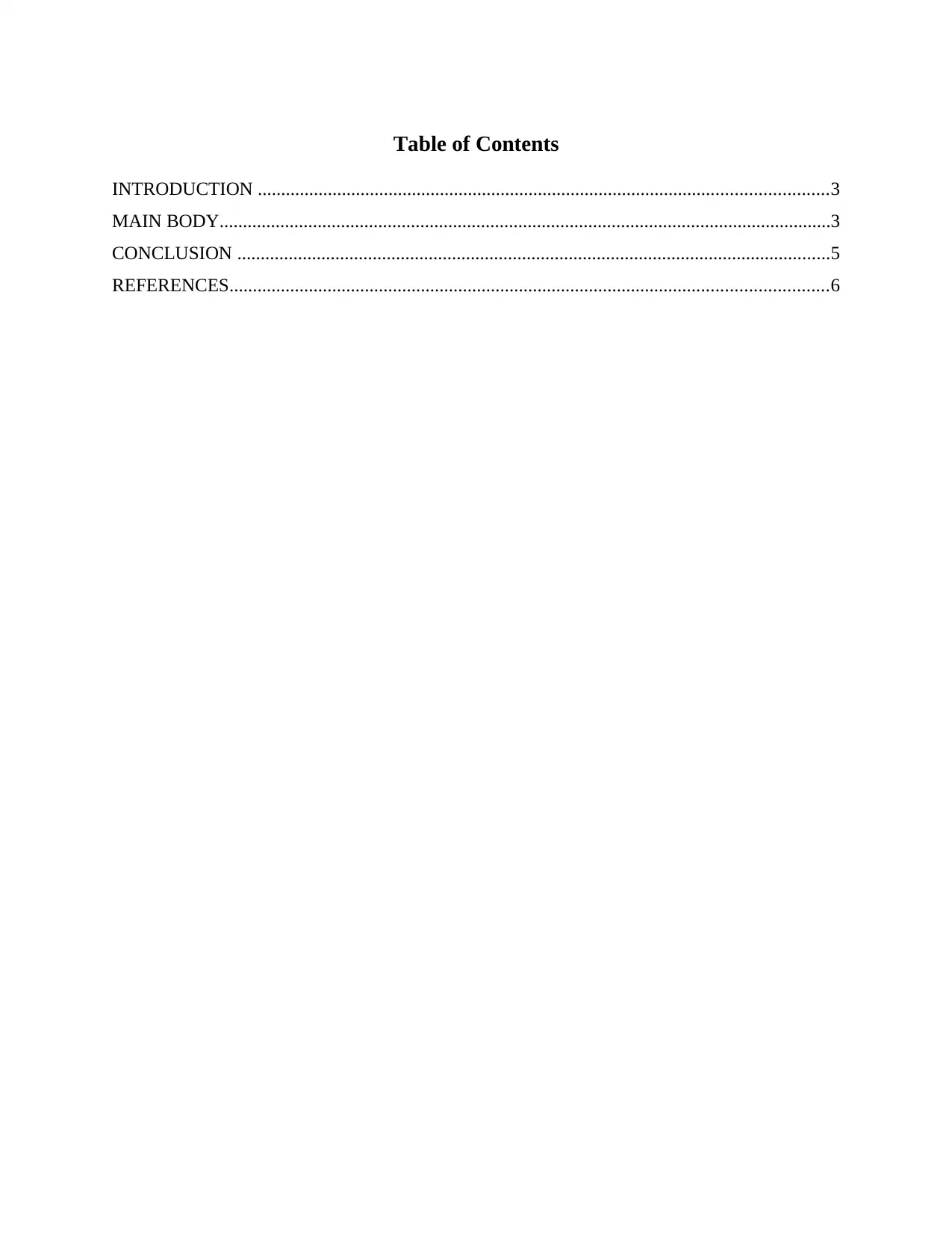
Table of Contents
INTRODUCTION ..........................................................................................................................3
MAIN BODY...................................................................................................................................3
CONCLUSION ...............................................................................................................................5
REFERENCES................................................................................................................................6
INTRODUCTION ..........................................................................................................................3
MAIN BODY...................................................................................................................................3
CONCLUSION ...............................................................................................................................5
REFERENCES................................................................................................................................6
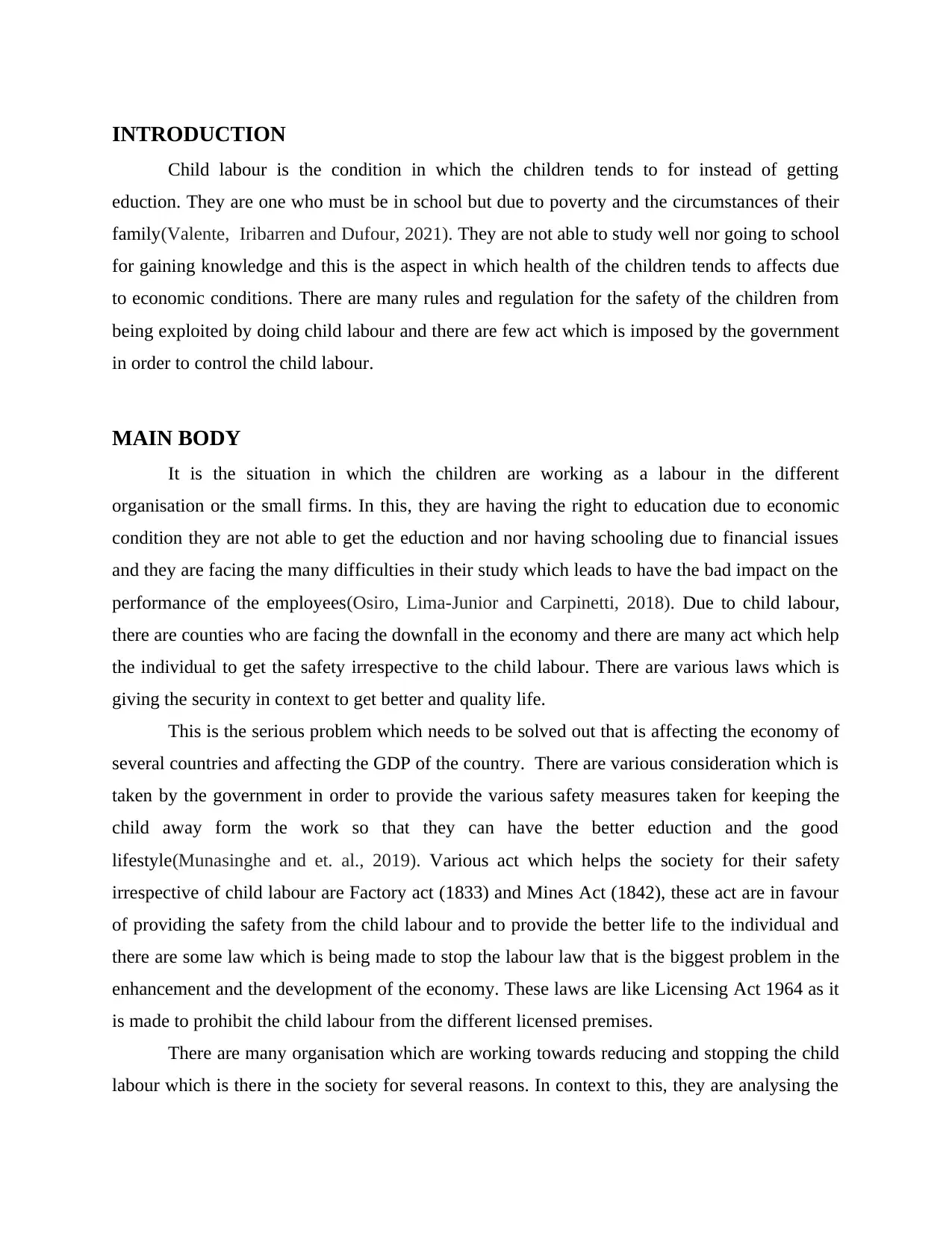
INTRODUCTION
Child labour is the condition in which the children tends to for instead of getting
eduction. They are one who must be in school but due to poverty and the circumstances of their
family(Valente, Iribarren and Dufour, 2021). They are not able to study well nor going to school
for gaining knowledge and this is the aspect in which health of the children tends to affects due
to economic conditions. There are many rules and regulation for the safety of the children from
being exploited by doing child labour and there are few act which is imposed by the government
in order to control the child labour.
MAIN BODY
It is the situation in which the children are working as a labour in the different
organisation or the small firms. In this, they are having the right to education due to economic
condition they are not able to get the eduction and nor having schooling due to financial issues
and they are facing the many difficulties in their study which leads to have the bad impact on the
performance of the employees(Osiro, Lima-Junior and Carpinetti, 2018). Due to child labour,
there are counties who are facing the downfall in the economy and there are many act which help
the individual to get the safety irrespective to the child labour. There are various laws which is
giving the security in context to get better and quality life.
This is the serious problem which needs to be solved out that is affecting the economy of
several countries and affecting the GDP of the country. There are various consideration which is
taken by the government in order to provide the various safety measures taken for keeping the
child away form the work so that they can have the better eduction and the good
lifestyle(Munasinghe and et. al., 2019). Various act which helps the society for their safety
irrespective of child labour are Factory act (1833) and Mines Act (1842), these act are in favour
of providing the safety from the child labour and to provide the better life to the individual and
there are some law which is being made to stop the labour law that is the biggest problem in the
enhancement and the development of the economy. These laws are like Licensing Act 1964 as it
is made to prohibit the child labour from the different licensed premises.
There are many organisation which are working towards reducing and stopping the child
labour which is there in the society for several reasons. In context to this, they are analysing the
Child labour is the condition in which the children tends to for instead of getting
eduction. They are one who must be in school but due to poverty and the circumstances of their
family(Valente, Iribarren and Dufour, 2021). They are not able to study well nor going to school
for gaining knowledge and this is the aspect in which health of the children tends to affects due
to economic conditions. There are many rules and regulation for the safety of the children from
being exploited by doing child labour and there are few act which is imposed by the government
in order to control the child labour.
MAIN BODY
It is the situation in which the children are working as a labour in the different
organisation or the small firms. In this, they are having the right to education due to economic
condition they are not able to get the eduction and nor having schooling due to financial issues
and they are facing the many difficulties in their study which leads to have the bad impact on the
performance of the employees(Osiro, Lima-Junior and Carpinetti, 2018). Due to child labour,
there are counties who are facing the downfall in the economy and there are many act which help
the individual to get the safety irrespective to the child labour. There are various laws which is
giving the security in context to get better and quality life.
This is the serious problem which needs to be solved out that is affecting the economy of
several countries and affecting the GDP of the country. There are various consideration which is
taken by the government in order to provide the various safety measures taken for keeping the
child away form the work so that they can have the better eduction and the good
lifestyle(Munasinghe and et. al., 2019). Various act which helps the society for their safety
irrespective of child labour are Factory act (1833) and Mines Act (1842), these act are in favour
of providing the safety from the child labour and to provide the better life to the individual and
there are some law which is being made to stop the labour law that is the biggest problem in the
enhancement and the development of the economy. These laws are like Licensing Act 1964 as it
is made to prohibit the child labour from the different licensed premises.
There are many organisation which are working towards reducing and stopping the child
labour which is there in the society for several reasons. In context to this, they are analysing the
⊘ This is a preview!⊘
Do you want full access?
Subscribe today to unlock all pages.

Trusted by 1+ million students worldwide
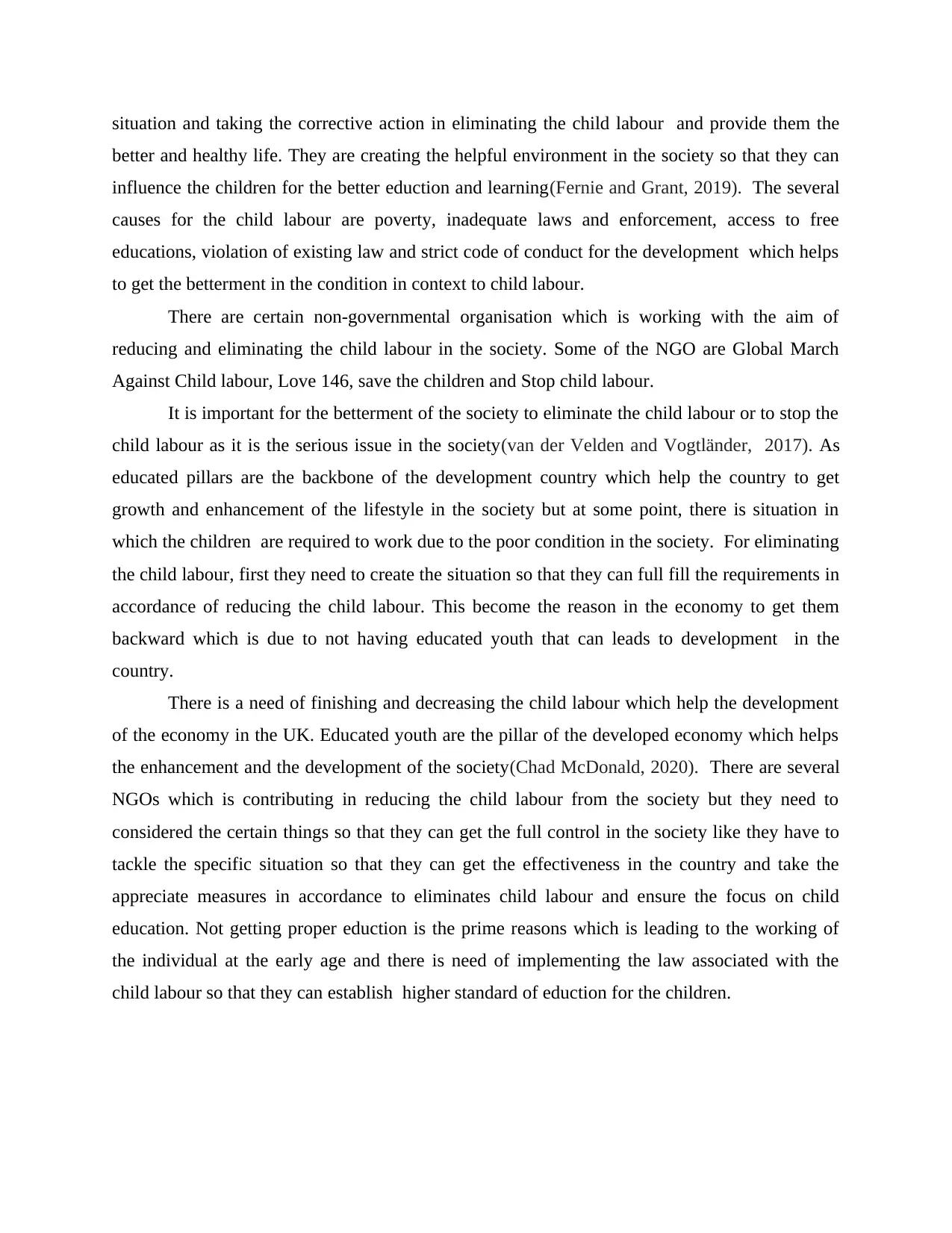
situation and taking the corrective action in eliminating the child labour and provide them the
better and healthy life. They are creating the helpful environment in the society so that they can
influence the children for the better eduction and learning(Fernie and Grant, 2019). The several
causes for the child labour are poverty, inadequate laws and enforcement, access to free
educations, violation of existing law and strict code of conduct for the development which helps
to get the betterment in the condition in context to child labour.
There are certain non-governmental organisation which is working with the aim of
reducing and eliminating the child labour in the society. Some of the NGO are Global March
Against Child labour, Love 146, save the children and Stop child labour.
It is important for the betterment of the society to eliminate the child labour or to stop the
child labour as it is the serious issue in the society(van der Velden and Vogtländer, 2017). As
educated pillars are the backbone of the development country which help the country to get
growth and enhancement of the lifestyle in the society but at some point, there is situation in
which the children are required to work due to the poor condition in the society. For eliminating
the child labour, first they need to create the situation so that they can full fill the requirements in
accordance of reducing the child labour. This become the reason in the economy to get them
backward which is due to not having educated youth that can leads to development in the
country.
There is a need of finishing and decreasing the child labour which help the development
of the economy in the UK. Educated youth are the pillar of the developed economy which helps
the enhancement and the development of the society(Chad McDonald, 2020). There are several
NGOs which is contributing in reducing the child labour from the society but they need to
considered the certain things so that they can get the full control in the society like they have to
tackle the specific situation so that they can get the effectiveness in the country and take the
appreciate measures in accordance to eliminates child labour and ensure the focus on child
education. Not getting proper eduction is the prime reasons which is leading to the working of
the individual at the early age and there is need of implementing the law associated with the
child labour so that they can establish higher standard of eduction for the children.
better and healthy life. They are creating the helpful environment in the society so that they can
influence the children for the better eduction and learning(Fernie and Grant, 2019). The several
causes for the child labour are poverty, inadequate laws and enforcement, access to free
educations, violation of existing law and strict code of conduct for the development which helps
to get the betterment in the condition in context to child labour.
There are certain non-governmental organisation which is working with the aim of
reducing and eliminating the child labour in the society. Some of the NGO are Global March
Against Child labour, Love 146, save the children and Stop child labour.
It is important for the betterment of the society to eliminate the child labour or to stop the
child labour as it is the serious issue in the society(van der Velden and Vogtländer, 2017). As
educated pillars are the backbone of the development country which help the country to get
growth and enhancement of the lifestyle in the society but at some point, there is situation in
which the children are required to work due to the poor condition in the society. For eliminating
the child labour, first they need to create the situation so that they can full fill the requirements in
accordance of reducing the child labour. This become the reason in the economy to get them
backward which is due to not having educated youth that can leads to development in the
country.
There is a need of finishing and decreasing the child labour which help the development
of the economy in the UK. Educated youth are the pillar of the developed economy which helps
the enhancement and the development of the society(Chad McDonald, 2020). There are several
NGOs which is contributing in reducing the child labour from the society but they need to
considered the certain things so that they can get the full control in the society like they have to
tackle the specific situation so that they can get the effectiveness in the country and take the
appreciate measures in accordance to eliminates child labour and ensure the focus on child
education. Not getting proper eduction is the prime reasons which is leading to the working of
the individual at the early age and there is need of implementing the law associated with the
child labour so that they can establish higher standard of eduction for the children.
Paraphrase This Document
Need a fresh take? Get an instant paraphrase of this document with our AI Paraphraser
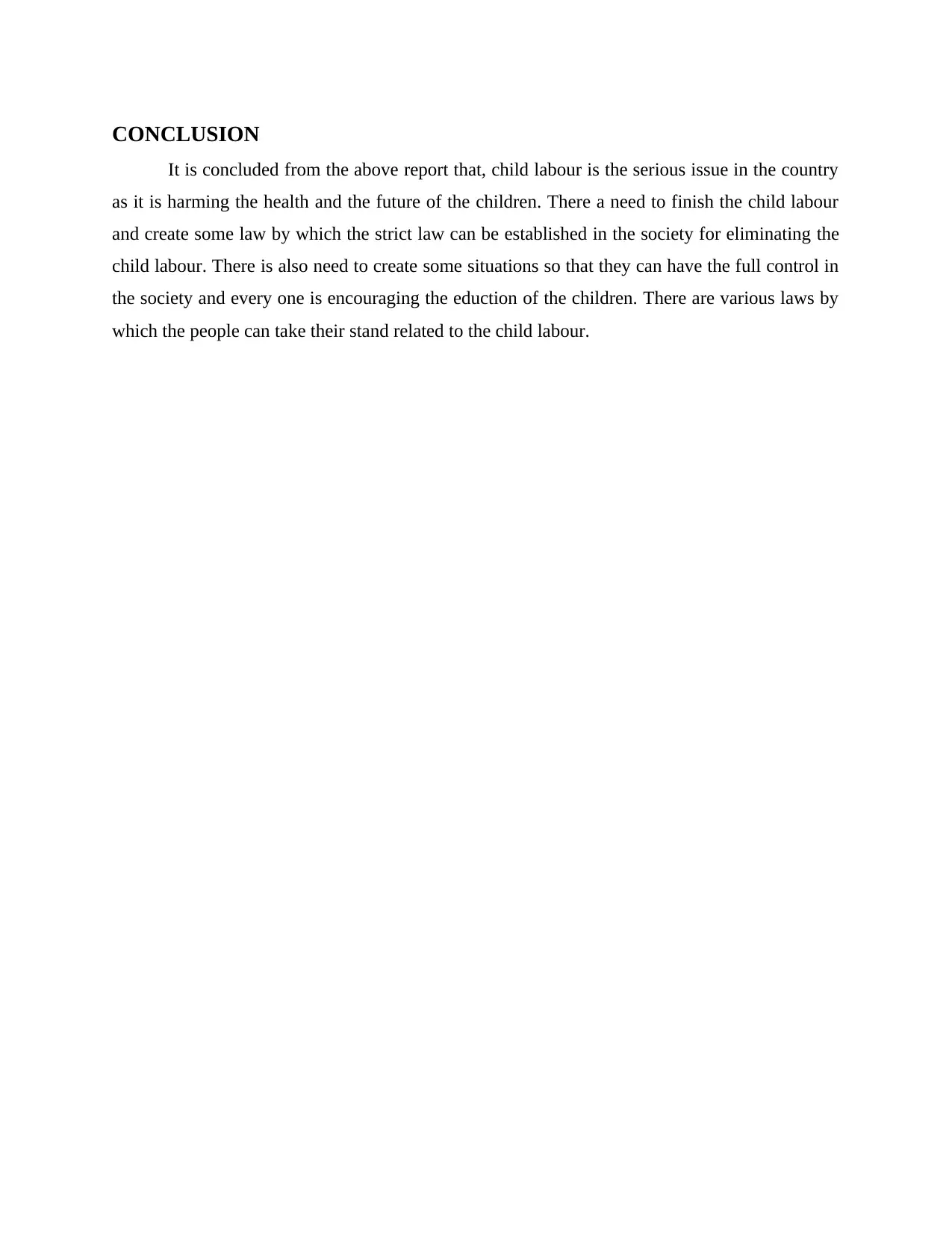
CONCLUSION
It is concluded from the above report that, child labour is the serious issue in the country
as it is harming the health and the future of the children. There a need to finish the child labour
and create some law by which the strict law can be established in the society for eliminating the
child labour. There is also need to create some situations so that they can have the full control in
the society and every one is encouraging the eduction of the children. There are various laws by
which the people can take their stand related to the child labour.
It is concluded from the above report that, child labour is the serious issue in the country
as it is harming the health and the future of the children. There a need to finish the child labour
and create some law by which the strict law can be established in the society for eliminating the
child labour. There is also need to create some situations so that they can have the full control in
the society and every one is encouraging the eduction of the children. There are various laws by
which the people can take their stand related to the child labour.
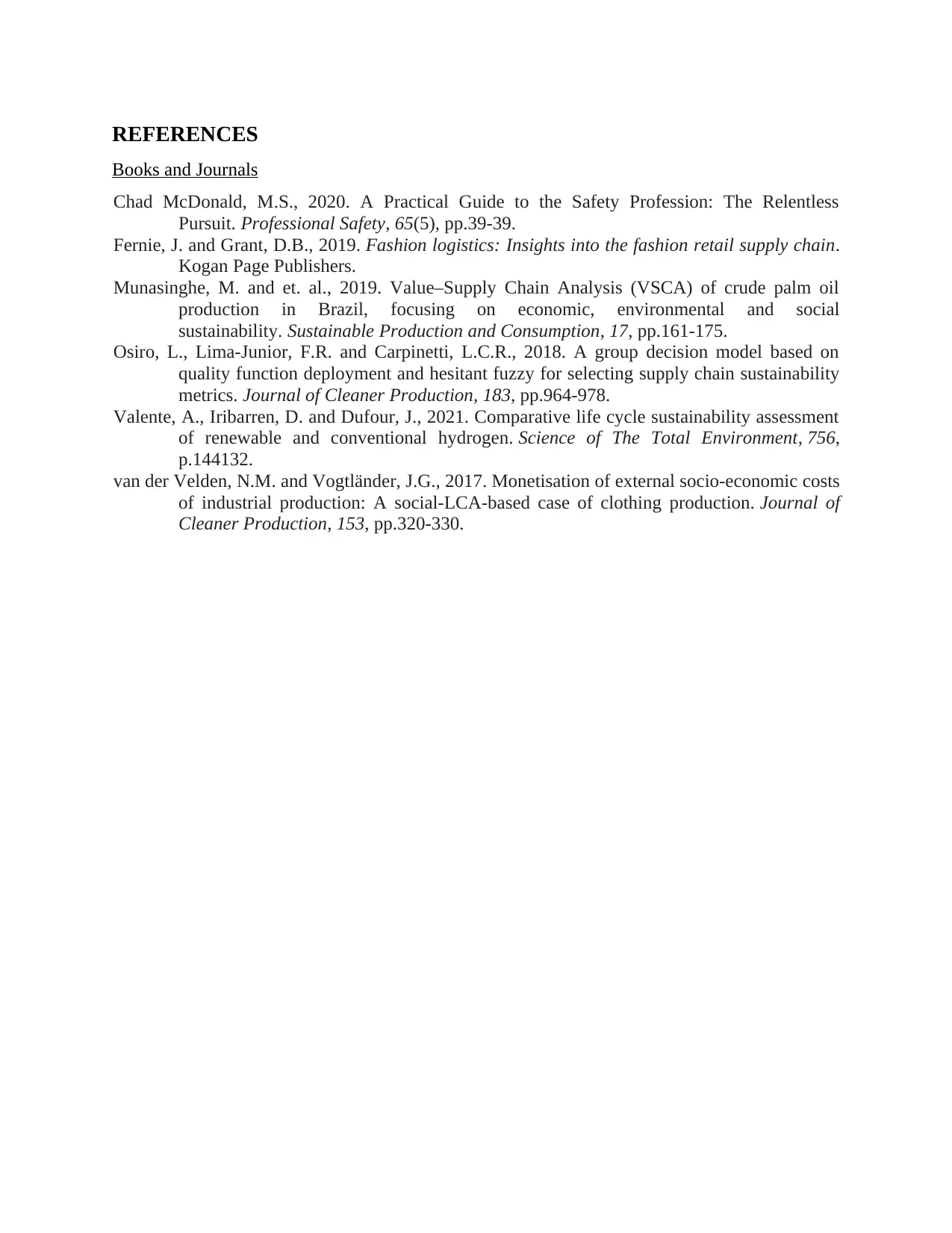
REFERENCES
Books and Journals
Chad McDonald, M.S., 2020. A Practical Guide to the Safety Profession: The Relentless
Pursuit. Professional Safety, 65(5), pp.39-39.
Fernie, J. and Grant, D.B., 2019. Fashion logistics: Insights into the fashion retail supply chain.
Kogan Page Publishers.
Munasinghe, M. and et. al., 2019. Value–Supply Chain Analysis (VSCA) of crude palm oil
production in Brazil, focusing on economic, environmental and social
sustainability. Sustainable Production and Consumption, 17, pp.161-175.
Osiro, L., Lima-Junior, F.R. and Carpinetti, L.C.R., 2018. A group decision model based on
quality function deployment and hesitant fuzzy for selecting supply chain sustainability
metrics. Journal of Cleaner Production, 183, pp.964-978.
Valente, A., Iribarren, D. and Dufour, J., 2021. Comparative life cycle sustainability assessment
of renewable and conventional hydrogen. Science of The Total Environment, 756,
p.144132.
van der Velden, N.M. and Vogtländer, J.G., 2017. Monetisation of external socio-economic costs
of industrial production: A social-LCA-based case of clothing production. Journal of
Cleaner Production, 153, pp.320-330.
Books and Journals
Chad McDonald, M.S., 2020. A Practical Guide to the Safety Profession: The Relentless
Pursuit. Professional Safety, 65(5), pp.39-39.
Fernie, J. and Grant, D.B., 2019. Fashion logistics: Insights into the fashion retail supply chain.
Kogan Page Publishers.
Munasinghe, M. and et. al., 2019. Value–Supply Chain Analysis (VSCA) of crude palm oil
production in Brazil, focusing on economic, environmental and social
sustainability. Sustainable Production and Consumption, 17, pp.161-175.
Osiro, L., Lima-Junior, F.R. and Carpinetti, L.C.R., 2018. A group decision model based on
quality function deployment and hesitant fuzzy for selecting supply chain sustainability
metrics. Journal of Cleaner Production, 183, pp.964-978.
Valente, A., Iribarren, D. and Dufour, J., 2021. Comparative life cycle sustainability assessment
of renewable and conventional hydrogen. Science of The Total Environment, 756,
p.144132.
van der Velden, N.M. and Vogtländer, J.G., 2017. Monetisation of external socio-economic costs
of industrial production: A social-LCA-based case of clothing production. Journal of
Cleaner Production, 153, pp.320-330.
⊘ This is a preview!⊘
Do you want full access?
Subscribe today to unlock all pages.

Trusted by 1+ million students worldwide
1 out of 6
Related Documents
Your All-in-One AI-Powered Toolkit for Academic Success.
+13062052269
info@desklib.com
Available 24*7 on WhatsApp / Email
![[object Object]](/_next/static/media/star-bottom.7253800d.svg)
Unlock your academic potential
Copyright © 2020–2025 A2Z Services. All Rights Reserved. Developed and managed by ZUCOL.





